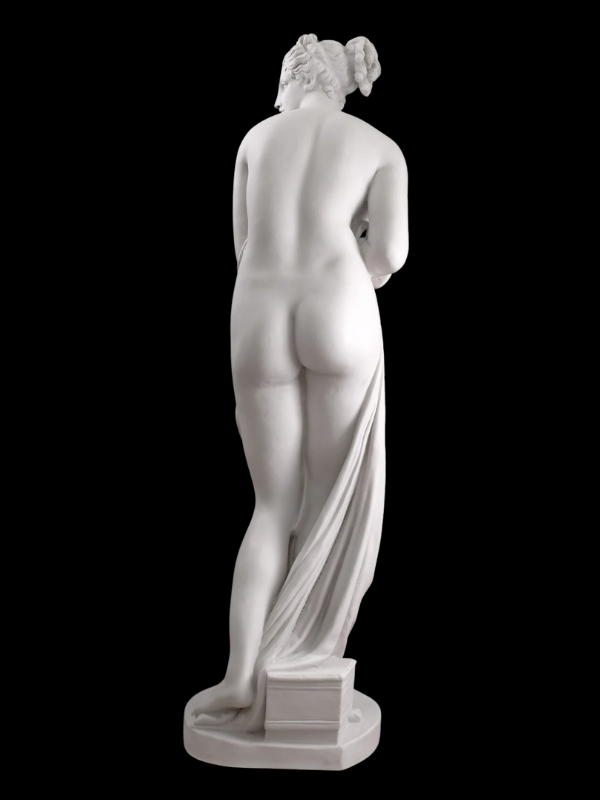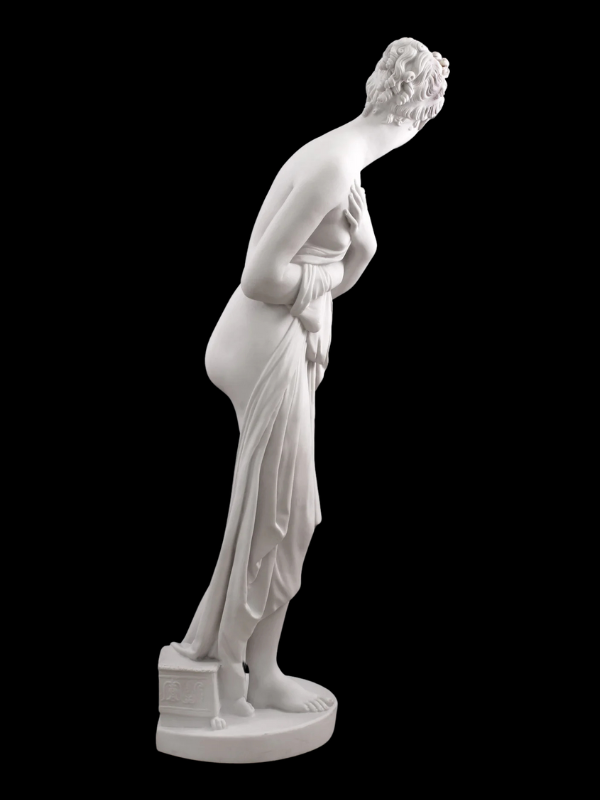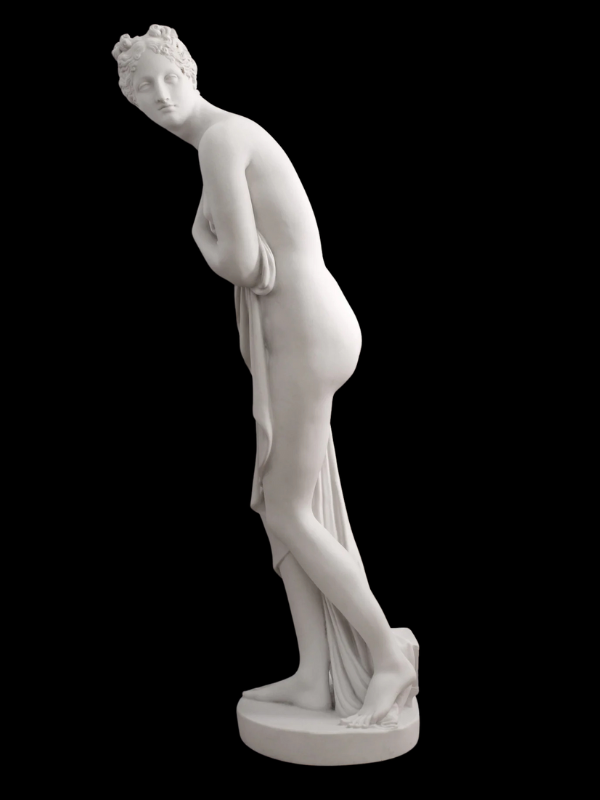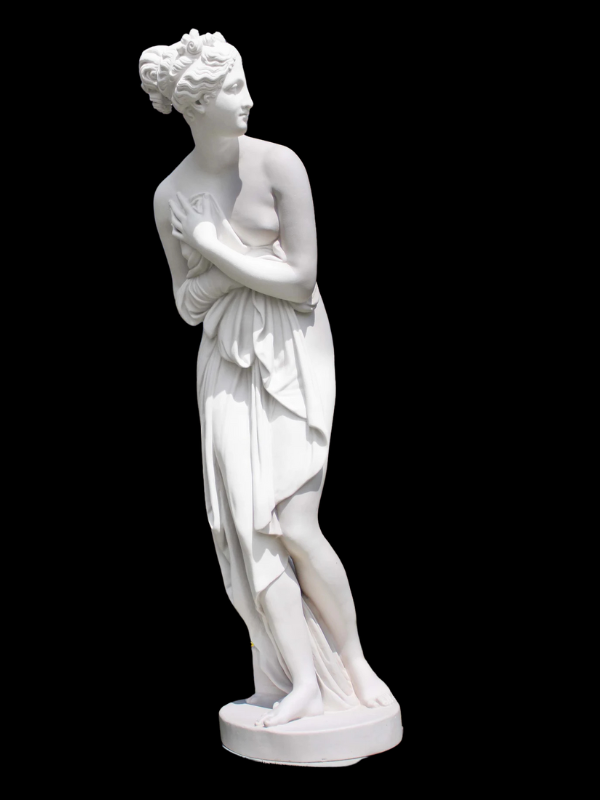Venus Italica Life Size Statue
Venus Italica Life Size Statue
Introducing the Venus Italica by Canova Life-size Statue (Large), a stunning reproduction masterpiece of the original Venus Italica sculpted by the legendary Antonio Canova in 1805. Canova, renowned for his masterful works during the Neoclassical period, created this sculpture as an embodiment of beauty, grace, and purity, and it remains one of his most famous depictions of Venus, the goddess of love and beauty. The original Venus Italica currently resides in the prestigious Palatine Gallery in Florence, where it continues to inspire and awe art enthusiasts around the world.
This life-size reproduction statue, made of natural white marble and architectural resin, perfectly captures the elegance and divine allure of the original. Standing at 172 cm (67.1 inches) tall, this sculptural masterpiece radiates the sophistication and timeless beauty that Canova himself sought to express through his work.
Historical Significance of Venus Italica
The Venus Italica was commissioned as a replacement for the Medici Venus, a classical sculpture that had been taken to France by Napoleon during the Napoleonic Wars. Canova’s reinterpretation of the goddess Venus was intended to maintain the classical ideals of beauty and perfection while bringing a more delicate, modest, and contemplative aspect to the figure of Venus.
In this sculpture, Venus is depicted in a moment of modesty, gracefully covering herself as she emerges from her bath. The softness of her pose and the tender expression of modesty in her features reveal Canova’s mastery of his craft, making this statue not just an image of a goddess but also an exploration of human emotion and divine beauty.
Dimensions and Materials
This life-size reproduction is meticulously crafted to bring Canova’s vision to life with precision and attention to detail.
- Height: The statue stands at 172 cm (67.1 inches), capturing the impressive life-size scale of the original and ensuring that it commands attention in any space.
- Width: The figure has a width of 47 cm (18.3 inches), providing a balanced and elegant profile that highlights the gracefulness of the goddess’s posture.
- Depth: With a depth of 67 cm (26.1 inches), the statue allows for a full appreciation of its intricate sculptural details from every angle.
- Weight: Weighing 47 kg (103.4 lbs), this statue is both sturdy and manageable, making it suitable for various display options while preserving the essence of a solid marble work.
The materials used in this reproduction—natural white marble combined with architectural resin—ensure a smooth and polished finish that closely resembles the original. The marble provides a luxurious and refined look, while the resin adds durability and flexibility, making this statue suitable for indoor display in any sophisticated setting.
Artistic Details and Pose
The Venus Italica is a perfect example of Canova’s ability to combine classical ideals with a more personal, human touch. Unlike many earlier depictions of Venus, which often emphasize her divine power and beauty, Canova’s Venus is more modest and introspective, portraying her in a private moment.
-
Graceful Modesty: The statue captures Venus at the moment she steps out of her bath, her arms raised delicately to cover her body. The gesture is modest, yet graceful, as her head turns slightly to the side, adding to the sense of introspection. This pose evokes both the strength and vulnerability of the goddess, making her feel both divine and human at once.
-
Soft Drapery: One of the most exquisite elements of Canova’s sculpture is the way he masterfully rendered the drapery that clings to Venus’s body. The light fabric seems to cascade naturally over her form, accentuating her curves without obscuring the delicate lines of her figure. This reproduction captures that same level of detail, with the flowing folds of the fabric adding a sense of movement and fluidity to the statue.
-
Tender Expression: The facial expression of the Venus Italica is one of modesty and contemplation. Unlike earlier, more confident or sensual representations of the goddess, Canova’s Venus appears introspective, her gaze lowered as though caught in a moment of private thought. This portrayal of Venus invites the viewer to consider not just her beauty but also her depth of character.
Symbolism of Venus and Classical Mythology
In classical mythology, Venus (known as Aphrodite in Greek mythology) was the goddess of love, beauty, and fertility. As one of the most prominent deities in both Roman and Greek mythological traditions, she was worshipped as a symbol of beauty, sensuality, and divine love.
-
Beauty and Grace: Venus is often associated with physical beauty, and many sculptures of the goddess focus on her idealized form. In Canova’s Venus Italica, however, her beauty is presented in a softer, more intimate manner. The modest pose and tender expression suggest a goddess who is aware of her own beauty but chooses to present herself with grace and humility.
-
Divine Love: As the goddess of love, Venus embodies both the physical and emotional aspects of love. In Canova’s sculpture, this is reflected in her introspective pose, as though she is contemplating the nature of love itself. The delicate rendering of her form and the softness of her expression emphasize the idea of love as something that is both powerful and tender.
-
Symbol of Purity: Unlike some other depictions of Venus, which emphasize her sensuality, Canova’s Venus Italica suggests a more pure and modest interpretation of the goddess. Her modest pose, combined with the careful rendering of her drapery, suggests a Venus who is not only beautiful but also dignified and virtuous.
Craftsmanship and Reproduction Process
The creation of this life-size reproduction involves a meticulous process that combines traditional craftsmanship with modern materials to ensure both aesthetic fidelity and durability.
-
Natural White Marble: The use of natural white marble gives the statue its pristine and luxurious appearance, closely mirroring the original marble of Canova’s sculpture. The marble’s smooth texture enhances the soft contours of Venus’s body and the delicate folds of her drapery.
-
Architectural Resin: The inclusion of architectural resin in the sculpture’s construction provides added strength and durability. This material is particularly useful in maintaining the intricate details of the statue while also ensuring that it can withstand various environmental conditions, making it ideal for both indoor and covered outdoor displays.
-
Precision in Detail: Every aspect of the original Venus Italica has been faithfully replicated in this life-size reproduction. From the soft curves of the goddess’s body to the intricate folds of her drapery, the attention to detail ensures that this statue retains the same sense of beauty and grace that made Canova’s original so iconic.
Display Options and Settings
The Venus Italica by Canova Life-size Statue is a versatile piece that can be displayed in a variety of settings, each enhancing the elegance and beauty of the sculpture.
-
Indoor Galleries and Homes: As a life-size representation of one of Canova’s most famous works, this statue makes a stunning addition to any art gallery, museum, or private collection. Its classical beauty and refined elegance make it a focal point in any room, whether displayed in a living room, foyer, or study.
-
Garden and Outdoor Spaces: While primarily intended for indoor display, the durable materials used in the statue’s construction allow it to be placed in covered outdoor areas such as gardens, patios, or courtyards. Surrounded by natural beauty, the Venus Italica creates a serene and contemplative atmosphere.
-
Cultural Exhibitions and Museums: As a reproduction of one of the most iconic sculptures of the Neoclassical period, this statue is an ideal addition to museum exhibitions or cultural displays. Its historical significance, combined with its aesthetic appeal, makes it a valuable piece for educational and cultural institutions.










